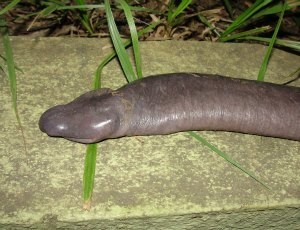Brazil Flora & Fauna News

PORTO VELHO, Brazil — Biologists have found five specimens of an exceedingly rare amphibian, Atretochoana eiselti, in the Brazilian Amazon, reported national media on Tuesday (31). The specimens, a species with an elongated cylindrical body and smooth skin, belonging to the family of so-called caecilians, were found near the construction site of a hydroelectric plant on the Madeira River in Porto Velho, capital of Rondônia state in Northern Brazil.

Atretochoana Eiselti Specimens Found
Biologists consider the animal very rare, since only two specimens of the species were known to exist before this and there was no clear information about the area where those originated, except that they came from “South America.” The biologists found six of the amphibians – they returned three to the river, one died and they sent two others to research centers.
Biologists collected the amphibians while rescuing animals exposed during the drying of the riverbed after construction of a cofferdam. “We would have never found the animals had the riverbed not been exposed after diverting the course of the river” said biologist Juliano Tupan, an analyst for Santo Antônio Energia, the company responsible for the project.
The animals were at the bottom of the Madeira River between stones that formed the Santo Antônio rapids, in the original bed of the river, exposed by the cofferdam.
Atretochoana eiselti is the scientific name of the rare snake-shaped, blind frog. The discovery occurred last December but they did not learn the species of the specimens until now. When they first found them in the riverbed they referred to the animals as simply, the “soft snakes.”
The cylindrical body of the frog could lead many to think that this is an odd type of snake. But Juliano explains that Atretochoana eiselti no relation with reptiles. “This frog is a close relative of salamanders, frogs and toads. It just looks like a snake, but it is not,” said the biologist.
“The Amazon is a surprise box in the case of amphibians and reptiles. Much remains to be discovered,” said the biologist.
According to Tupan, discovering where the Atretochoana eiselti lives is very important. The two specimens found before, preserved in the Natural History Museum in Vienna and the Department of Biological Sciences, University of Brasília, have no specific origin.
“So, we have rediscovered a species thanks to a cofferdam. Now we are sure that this animal is present in the Madeira River basin and Pará [state],” said the biologist, referring to two other specimens found recently in Mosqueiro Island in Belém.
With a larger collection of specimens, we have broader prospects for studying the species. One of the amphibian’s unique aspects–sure to draw attention from researchers–is that the animal doesn’t have lungs and breaths through its skin.
Men Swimming With Giant Green Anaconda

Brazil Dispatch is the leading source for unique Brazil News online.



It’s not a frog.
Pingback: Hyalinobatrachium iaspidiense: 'Glass Frog' - Brazil Dispatch